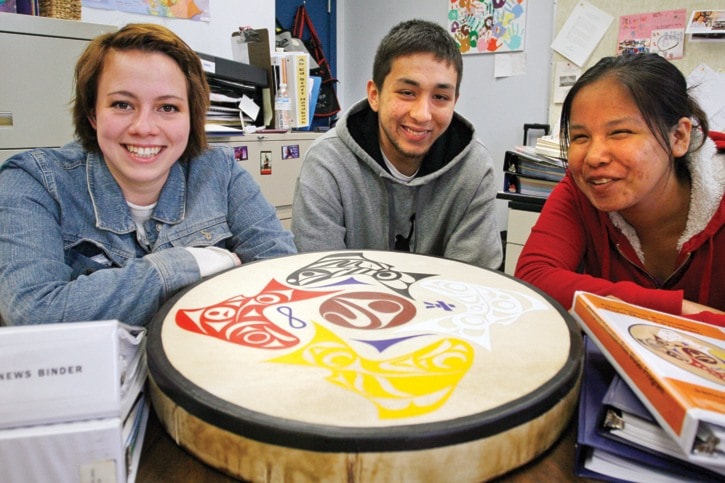When Lilly Wass was in Grade 11 in Ontario, she didn’t bother to go to class, let alone care about her grades.
She was barely passing her courses, but now, after spending the past three semesters in the Sooke School District, she is set to graduate with an 88 per cent average.
“In Ontario we didn’t have an aboriginal education room. It makes a lot of difference,” said Wass said, an Edward Milne community school student. “There is someone you can go and talk to and they see if I am keeping up with my work.”
This spring, SD 62 will celebrate its first graduating class with more than 100 aboriginal students. The unofficial count is at 104, up from the 51 who graduated last year.
Kathleen King-Hunt, SD 62 district principal for aboriginal education, said the district has worked to integrate aboriginal curriculum into course material.
“The (aboriginal) graduate rate is something we have worked very hard at. The aboriginal enhancement agreement makes a difference in the classroom,” King-Hunt said. “Our success is not just graduation rates.”
The district expects the aboriginal completion rate to continue its upward surge. Last year, 73 per cent of all aboriginal students graduated within six years starting from Grade 8, which is close to the overall average of 76 per cent for SD 62 students. The provincial aboriginal completion rate is about 51 per cent.
Five years ago, only 38 per cent of aboriginal students were graduating from SD 62.
First Nations students at Belmont secondary, Edward Milne and West Shore Annex schools credit part of their success to aboriginal education rooms staffed with teachers and support workers.
“(Aboriginal education teachers) put in more time and effort and they don’t act like it is just their job,” Wass said. “With me, home life isn’t that great, and (at school) there is someone willing to help.”
Dahlila Charlie, a Grade 12 student, has spent her three years using the services in the aboriginal education room at Belmont secondary.
“They are just so supportive and they have connections with all the students,” Charlie said. “It gives us our own space in the school. School is important and culture is important. Here the two are together and that’s awesome.”
Charlie is so grateful for the help she has received from the program, she has begun mentoring other aboriginal students at Spencer middle school. She is attending summer programs at Emily Carr University and applied for the University of Victoria visual arts program.
Kathy Sudlow, an aboriginal education teacher at Edward Milne, said the aboriginal education room is classified as an all-nations room and students from any background are welcome to use its services.
“If you are in a class with 30 kids, how many times are you going to put your hand up when you still don’t get it?” Sudlow said. “Often when kids come for help, they get me to themselves.”
With education space and an enhancement agreement that establishes a strong aboriginal component in the classroom, SD 62 has become a leader in the province for aboriginal eduction.
SD 62 has the highest aboriginal grad rate on the Island and is ranked No. 1 in the province for a school district of its size, and fourth in the province overall.
West Shore Annex student Arthur Smith said without aboriginal education, he doubts he would be in school.
“It’s a good last resort,” said Smith, who will become the first in his family to graduate from high school. “They are open and help you professionally, and for troubles out of school, they’ll help you with that too.”
reporter@goldstreamgazette.com
